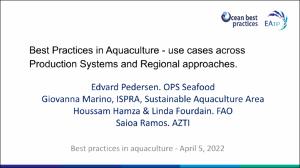| dc.contributor.author | Pedersen, Edvard | |
| dc.contributor.author | Marino, Giovanna | |
| dc.contributor.author | Hamza, Houssam | |
| dc.contributor.author | Ramos, Saioa | |
| dc.date.accessioned | 2022-05-20T09:02:34Z | |
| dc.date.available | 2022-05-20T09:02:34Z | |
| dc.date.issued | 2022 | |
| dc.identifier.citation | Pedersen, E., Marino, G., Hamza, H. and Ramos, S. (2022) Best Practices in Aquaculture - use cases across Production Systems and Regional approaches. [Presentations at the EATiP/OBPS Best Practices in Aquaculture Workshop, 05 April 2022 (Online)], 10 slides, DOI: http://dx.doi.org/10.25607/OBP-1750 | en_US |
| dc.identifier.uri | https://repository.oceanbestpractices.org/handle/11329/1927 | |
| dc.identifier.uri | http://dx.doi.org/10.25607/OBP-1750 | |
| dc.description.abstract | Edvard Pedersen | The Brønnøysund Register Centre : OPS Seafood
As a first example, a bimodal concept for Public-Private Sector Development and digital transformation was explained. It is based on a generic cooperation model applied to the Norwegian seafood sector. The public sector contributes with public data, data gathering and transfer, and common standards. The sector takes the responsibility for sector-specific standards, data ownership management and common sector solutions. A code of conduct was developed and the data sharing was standardised. The model itself can be regarded as a best practice, as well as the products resulting from it. -----
Giovanna Marino | ISPRA : The PerformFish benchmarking system
The system was developed for the Mediterranean area, based on Key Performance Indicators (KPIs) identified by the industry and that can be collected at the farms. These cover technical, environmental, welfare and economic indicator categories. It resulted in a benchmarking system that was adopted by aquaculture stakeholders and associations and in a unique data set across different Mediterranean zones on the performance of aquaculture farms. The system enables a visualisation of a set of KPIs and the optimisation of different aspects across the production cycle. With this information the sector has a tool that can document the sustainability of aquaculture, e.g. related to welfare issues or the carbon footprint of aquaculture. -----
Houssam Hamza & Linda Fourdain | GFCM of FAO : Best practices at
the Global Mediterranean Council
The FAO GFCM is the general Fisheries Commission for the Mediterranean and the Black Sea. It produces recommendations and resolutions for aquaculture in the region and provides assistance, demonstration centres, training courses driving good practices across the GFCM member countries and coastal communities. A methodology and guidance for knowledge and good practice sharing has been developed for aquaculture in marine spatial planning, such as the guide for Allocated Zones for Aquaculture (AZA). -----
Saioa Ramos | AZTI : AQUAPEF: an aquaculture Product
Environmental Footprint pilot
The EU funded project Life AQUAPEF developed a specific, easy-to-use tool to calculate the Product Environmental Footprint (PEF) across the aquaculture value chain, from feed, hatchery and grow out to processing, packaging and distribution. The pilot tool has been demonstrated at different sites in the Mediterranean and is ready to be used by all sea bream and seabass farms in the region. The goal is to have the tool commercialised and to transfer the methodology to other aquaculture systems and species, such as salmon, trout and sole. | en_US |
| dc.language.iso | en | en_US |
| dc.title | Best Practices in Aquaculture - use cases across Production Systems and Regional approaches. [Presentations at the EATiP/OBPs Best Practices in Aquaculture Workshop, 05 April 2022 (Online)]. | en_US |
| dc.type | Report | en_US |
| dc.description.status | Published | en_US |
| dc.format.pages | 10 slides | en_US |
| dc.subject.parameterDiscipline | Fisheries and aquaculture | en_US |
| dc.description.currentstatus | Current | en_US |
| dc.description.sdg | 14.a | en_US |
| dc.description.methodologyType | Method | en_US |
| obps.contact.contactemail | alexandra@eatip.eu | |
 Repository of community practices in Ocean Research, Applications and Data/Information Management
Repository of community practices in Ocean Research, Applications and Data/Information Management
